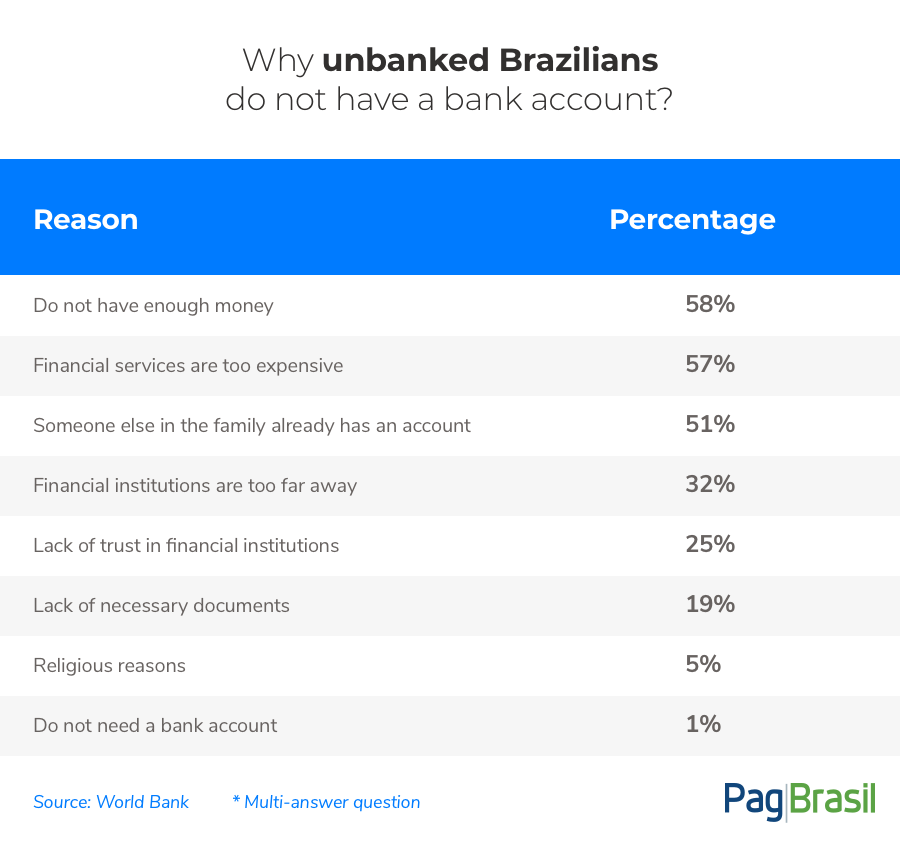Globally, e-commerce represents 12% of all retail sales. By 2022, eMarketer estimates that the segment will have a share of over 20%. In part, the growth will be motivated by digital inclusion, which will enable more consumers to purchase online worldwide.
However, according to the World Bank, there are still 1.7 billion unbanked adults in the world. In Brazil, Instituto Data Popular estimates that 55 million adults have no bank account or any other ties with traditional banking institutions. This represents over 26% of the country’s population and nearly 40% of all adult Brazilians.
The challenge then lies in enabling e-commerce for the unbanked. Here is where alternative payment methods play a big role. Fintech companies, in particular, are driving disruption and introducing new technologies that democratize access to e-commerce. Good examples of that are PagBrasil’s PEC Flash™ and Boleto Flash®.
Profile of Unbanked Brazilians
It is estimated that the unbanked population in Brazil contributes approximately BRL 655 billion to the local economy. Unlike what most would believe, unbanked Brazilians are present in every social group, with 11% in the higher-income group, 48% in the middle-income group and 37% in the lower-income group.
Geographically, the unbanked population is also distributed all over the Brazilian territory. While in the north and northeast regions nearly half of the population does not have a bank account, in the center-west, south and southeast states, about 30% of all adults are unbanked.
Among the reasons to remain unbanked, nearly 60% of adults without a bank account indicate that they do not have enough money to have a bank account. Banks have their requirements, and many adults do not meet the necessary demands from financial institutions. In addition, if someone has a poor credit history or is in a debt situation, banks are likely to deny their requests for an account.
Another reason that 32% are unbanked is because they do not have a bank branch nearby. This explains why a larger share of the population in the north and northeast regions is still unbanked, as they have a smaller concentration of banks in comparison to other regions of Brazil.

Alternative Payment Methods for the Unbanked
For a long time, the only alternative means of payment for the unbanked in Brazil was boleto bancário. However, this popular Brazilian payment method had its drawbacks, such as delayed payment confirmation of up to three business days and lack of a responsive layout to ease its use on mobile devices.
In recent years, fintech companies like PagBrasil have introduced new options that enable unbanked consumers to purchase online, such as prepaid cards, payment accounts, Boleto Flash®, and PEC Flash™.
Boleto Flash® was first introduced in 2015, creating a better boleto solution for the Brazilian market. Not only does it have a responsive layout, it also provides payment confirmation within two hours, a major improvement. This way, consumers can enjoy a better buying experience, as they do not have to wait as long to have their purchases sent or delivered to them.
PEC Flash™, on the other hand, is PagBrasil’s newest solution aiming at inclusion. It is a cash payment method created for e-commerce that enables anyone to pay their online purchases in cash at any lottery agency in Brazil. To top it off, the payment confirmation takes only a few minutes.
Would you like to learn more about PagBrasil’s solutions for the unbanked? Visit www.boletoflash.com and www.pecflash.com.

Comment
[…] meant that it was available for the majority of banked Brazilians. In addition, it also served the unbanked population, who pay their boletos at the more than 13,000 lottery agencies in […]